Increasing Efficiency of a Finned Heat Sink Using Orthogonal Analysis
Abstract
1. Introduction
2. Numerical Simulation of the Heat Sink Model
2.1. Computational Model
2.2. Governing Equations
2.3. Boundary Conditions and Algorithm
2.4. Validation of Grid Independence
2.5. Validation of the Model
3. Numerical Simulation and Orthogonal Analysis
3.1. The Factors and Levels of the Orthogonal Analysis
3.2. Orthogonal Array
3.3. Range Analysis
4. Results and Discussion
4.1. Solutions of the Cases
4.2. Range Analysis
4.3. Integrated Performance Analysis
5. Conclusions
Author Contributions
Funding
Institutional Review Board Statement
Informed Consent Statement
Data Availability Statement
Acknowledgments
Conflicts of Interest
Nomenclature
| B | thickness of substrate |
| Cp | specific heat capacity of fluid |
| F | integrated performance index |
| f | proportion factor |
| g | gravitational acceleration |
| H | height |
| k | thermal conductivity of solid |
| L1 | length |
| L2 | width |
| N | number of fins |
| p | pressure |
| qw | heat flux |
| Rj | range |
| Tmax | maximum temperature |
| Tf | temperature of fluid |
| Ts | temperature of solid |
| u, v, w | velocity |
| x, y, z | spatial coordinates |
| Greek Symbols | |
| α, β | weight coefficient |
| λ | thermal conductivity of fluid |
| ρ | density |
| μ | dynamic viscosity |
References
- Wei, J. Challenges in Cooling Design of CPU Packages for High-Performance Servers. Heat Transf. Eng. 2008, 29, 178–187. [Google Scholar] [CrossRef]
- Bailey, C. Thermal Management Technologies for Electronic Packaging: Current Capabilities and Future Challenges for Modelling Tools. In Proceedings of the 2008 10th Electronics Packaging Technology Conference, Singapore, 9–12 December 2008; pp. 527–532. [Google Scholar]
- Siricharoenpanich, A.; Wiriyasart, S.; Srichat, A.; Naphon, P. Thermal management system of CPU cooling with a novel short heat pipe cooling system. Case Stud. Therm. Eng. 2019, 15, 100545. [Google Scholar] [CrossRef]
- Li, F.; Ma, Q.; Xin, G.; Zhang, J.; Wang, X. Heat transfer and flow characteristics of microchannels with solid and porous ribs. Appl. Therm. Eng. 2020, 178, 115639. [Google Scholar] [CrossRef]
- Gagliano, S.; Cairone, F.; Amenta, A.; Bucolo, M. A Real Time Feed forward Control of Slug Flow in Microchannels. Energies 2019, 12, 2556. [Google Scholar] [CrossRef]
- Laguna, G.; Vilarrubí, M.; Ibañez, M.; Betancourt, Y.; Illa, J.; Azarkish, H.; Amnache, A.; Collin, L.; Coudrain, P.; Fréchette, L.; et al. Numerical parametric study of a hotspot-targeted micro-fluidic cooling array for microelectronics. Appl. Therm. Eng. 2018, 144, 71–80. [Google Scholar] [CrossRef]
- Anandan, P.; Gagliano, S.; Bucolo, M. Computational models in microfluidic bubble logic. Microfluid. Nanofluidics 2014, 18, 305–321. [Google Scholar] [CrossRef]
- Zhang, K.; Li, M.-J.; Wang, F.-L.; He, Y.-L. Experimental and numerical investigation of natural convection heat transfer of W-type fin arrays. Int. J. Heat Mass Transf. 2020, 152, 119315. [Google Scholar] [CrossRef]
- Naserian, M.M.; Fahiminia, M.; Goshayeshi, H.R. Experimental and numerical analysis of natural convection heat transfer coefficient of V-type fin configurations. J. Mech. Sci. Technol. 2013, 27, 2191–2197. [Google Scholar] [CrossRef]
- Altun, A.H.; Ziylan, O. Experimental investigation of the effects of horizontally oriented vertical sinusoidal wavy fins on heat transfer performance in case of natural convection. Int. J. Heat Mass Transf. 2019, 139, 425–431. [Google Scholar] [CrossRef]
- Nilpueng, K.; Ahn, H.S.; Jerng, D.-W.; Wongwises, S. Heat transfer and flow characteristics of sinusoidal wavy plate fin heat sink with and without crosscut flow control. Int. J. Heat Mass Transf. 2019, 137, 565–572. [Google Scholar] [CrossRef]
- El Ghandouri, I.; El Maakoul, A.; Saadeddine, S.; Meziane, M. Design and numerical investi-gations of natural convection heat transfer of a new rippling fin shape. Appl. Therm. Eng. 2020, 178, 115670. [Google Scholar] [CrossRef]
- Shyu, J.-C.; Jheng, J.-S. Heat Transfer Enhancement of Plate-Fin Heat Sinks with Different Types of Winglet Vortex Generators. Energies 2020, 13, 5219. [Google Scholar] [CrossRef]
- Shaeri, M.; Yaghoubi, M. Thermal enhancement from heat sinks by using perforated fins. Energy Convers. Manag. 2009, 50, 1264–1270. [Google Scholar] [CrossRef]
- Huang, G.-J.; Wong, S.-C.; Lin, C.-P. Enhancement of natural convection heat transfer from horizontal rectangular fin arrays with perforations in fin base. Int. J. Therm. Sci. 2012, 84, 164–174. [Google Scholar] [CrossRef]
- Maji, A.; Bhanja, D.; Patowari, P.K. Numerical investigation on heat transfer enhancement of heat sink using perforated pin fins with inline and staggered arrangement. Appl. Therm. Eng. 2017, 125, 596–616. [Google Scholar] [CrossRef]
- Tariq, A.; Altaf, K.; Ahmad, S.W.; Hussain, G.; Ratlamwala, T.A.H. Comparative numerical and ex-perimental analysis of thermal and hydraulic performance of improved plate fin heat sinks. Appl. Therm. Eng. 2021, 182, 115949. [Google Scholar]
- Yang, Y.-T.; Peng, H.-S. Numerical study of pin-fin heat sink with un-uniform fin height design. Int. J. Heat Mass Transf. 2008, 51, 4788–4796. [Google Scholar] [CrossRef]
- Yang, Y.-T.; Peng, H.-S. Numerical study of the heat sink with un-uniform fin width designs. Int. J. Heat Mass Transf. 2009, 52, 3473–3480. [Google Scholar] [CrossRef]
- Huang, C.-H.; Chen, Y.-H. An impingement heat sink module design problem in determining simultaneously the optimal non-uniform fin widths and heights. Int. J. Heat Mass Transf. 2014, 73, 627–633. [Google Scholar] [CrossRef]
- Huang, C.-H.; Chen, Y.-H.; Li, H.-Y. An impingement heat sink module design problem in determining opti-mal non-uniform fin widths. Int. J. Heat Mass Transf. 2013, 67, 992–1006. [Google Scholar] [CrossRef]
- Arshad, A.; Jabbal, M.; Sardari, P.T.; Bashir, M.A.; Faraji, H.; Yan, Y. Transient simulation of finned heat sinks embedded with PCM for electronics cooling. Therm. Sci. Eng. Prog. 2020, 18, 100520. [Google Scholar] [CrossRef]
- Ghanbarpour, A.; Hosseini, M.J.; Ranjbar, A.A.; Rahimi, M.; Bahrampoury, R.; Ghanbarpour, M. Evaluation of heat sink per-formance using PCM and vapor chamber/heat pipe. Renew. Energy 2021, 163, 698–719. [Google Scholar] [CrossRef]
- Kalbasi, R.; Afrand, M.; Alsarraf, J.; Tran, M.D. Studies on optimum fins number in PCM-based heat sinks. Energy 2019, 171, 1088–1099. [Google Scholar] [CrossRef]
- Yazici, M.Y.; Avci, M.; Aydin, O. Combined effects of inclination angle and fin number on thermal perfor-mance of a PCM-based heat sink. Appl. Therm. Eng. 2019, 159, 113956. [Google Scholar] [CrossRef]
- Jiaqiang, E.; Han, D.; Qiu, A.; Zhu, H.; Deng, Y.; Chen, J.; Zhao, X.; Zuo, W.; Wang, H.; Chen, J.; et al. Orthogonal experimental design of liquid-cooling structure on the cooling effect of a liq-uid-cooled battery thermal management system. Appl. Therm. Eng. 2018, 132, 508–520. [Google Scholar]
- Xiang, J.; Zhang, C.; Zhou, C.; Huang, J.; Liu, G.; Zhao, H. An integrated radial heat sink with thermosiphon for high-power LEDs applications. Heat Mass Transf. 2019, 55, 2455–2467. [Google Scholar] [CrossRef]
- Liu, Y.; Wu, R.; Yang, P.; Wang, T.; Liu, H.; Wang, L. Parameter study of the injection configuration in a zero boil-off hydrogen storage tank using orthogonal test design. Appl. Therm. Eng. 2016, 109, 283–294. [Google Scholar] [CrossRef]
- Wu, X.; Leung, D.Y. Optimization of biodiesel production from camelina oil using orthogonal experiment. Appl. Energy 2011, 88, 3615–3624. [Google Scholar] [CrossRef]
- Yang, K.-S.; Chu, W.-H.; Chen, I.-Y.; Wang, C.-C. A comparative study of the airside performance of heat sinks having pin fin configurations. Int. J. Heat Mass Transf. 2007, 50, 4661–4667. [Google Scholar] [CrossRef]
- Moffat, R.J. Describing the uncertainties in experimental results. Exp. Therm. Fluid Sci. 1988, 1, 3–17. [Google Scholar] [CrossRef]
- Tang, J.; Gong, G.; Su, H.; Wu, F.; Herman, C. Performance evaluation of a novel method of frost pre-vention and retardation for air source heat pumps using the orthogonal experiment design method. Appl. Energy 2016, 169, 696–708. [Google Scholar] [CrossRef]
- Deng, L.; Feng, B.; Zhang, Y. An optimization method for multi-objective and multi-factor designing of a ceramic slurry: Combining orthogonal experimental design with artificial neural networks. Ceram. Int. 2018, 44, 15918–15923. [Google Scholar] [CrossRef]
- Chiang, K.-T.; Chang, F.-P.; Tsai, T.-C. Optimum design parameters of Pin-Fin heat sink using the grey-fuzzy logic based on the orthogonal arrays. Int. Commun. Heat Mass Transf. 2006, 33, 744–752. [Google Scholar] [CrossRef]
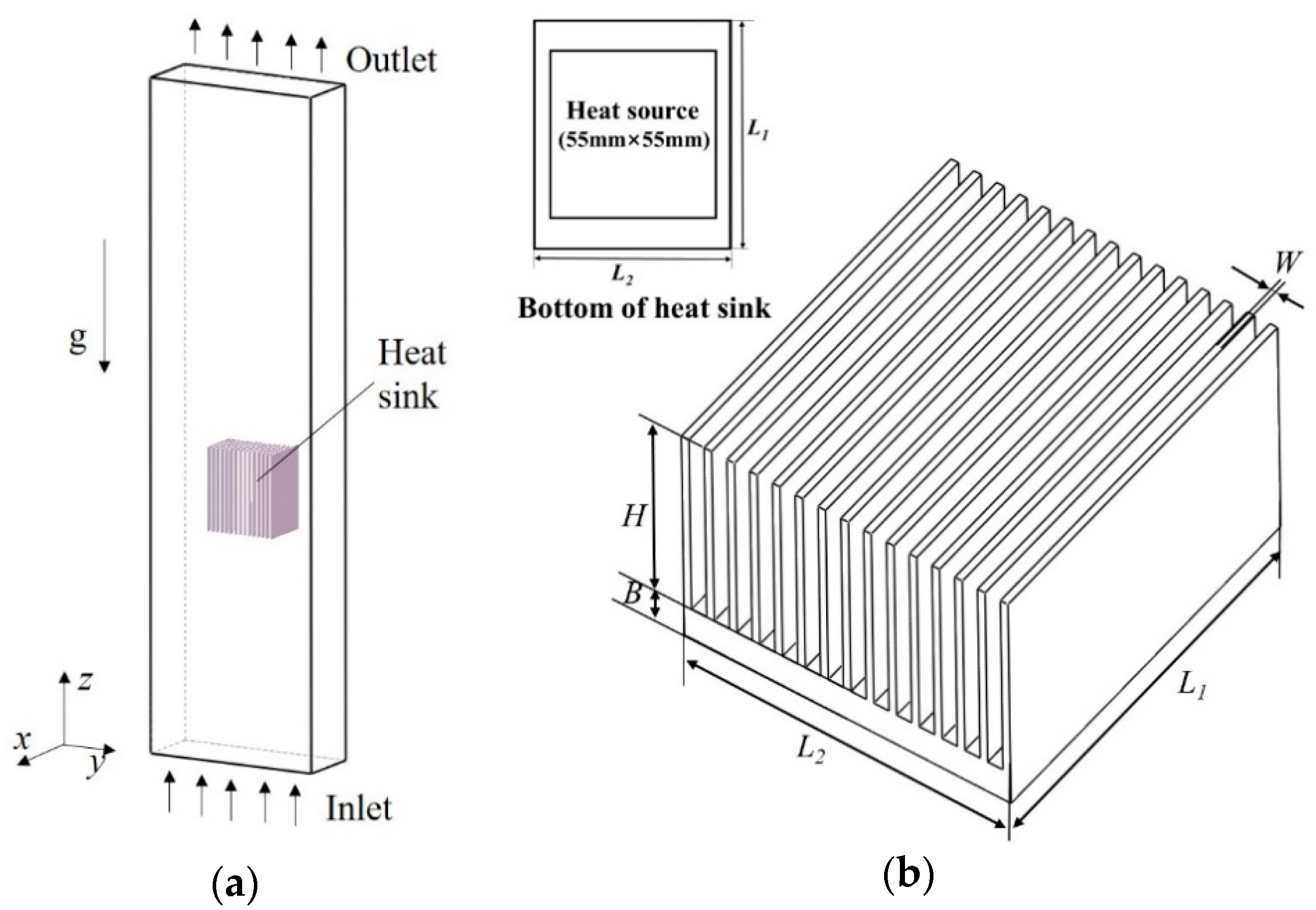
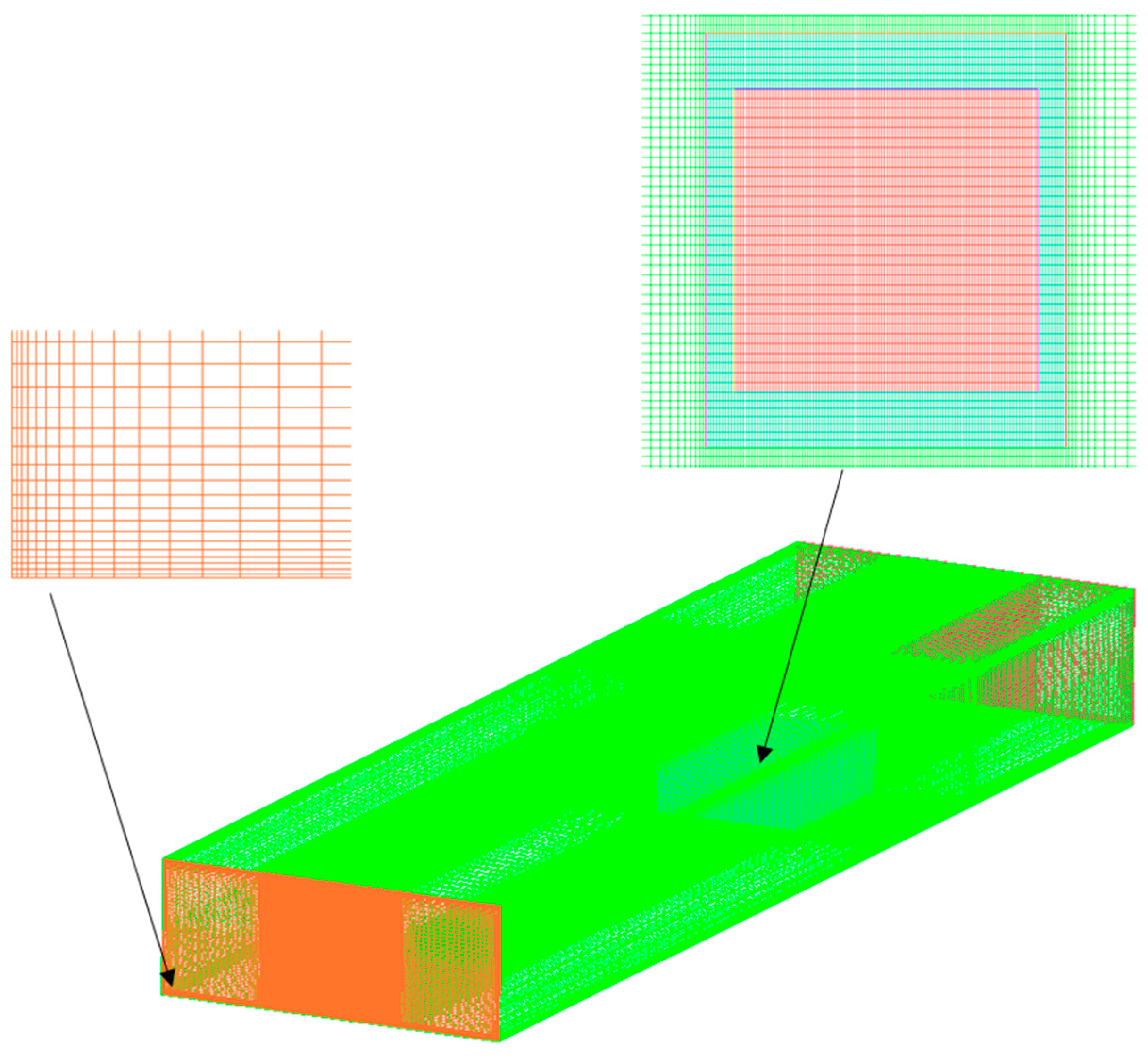
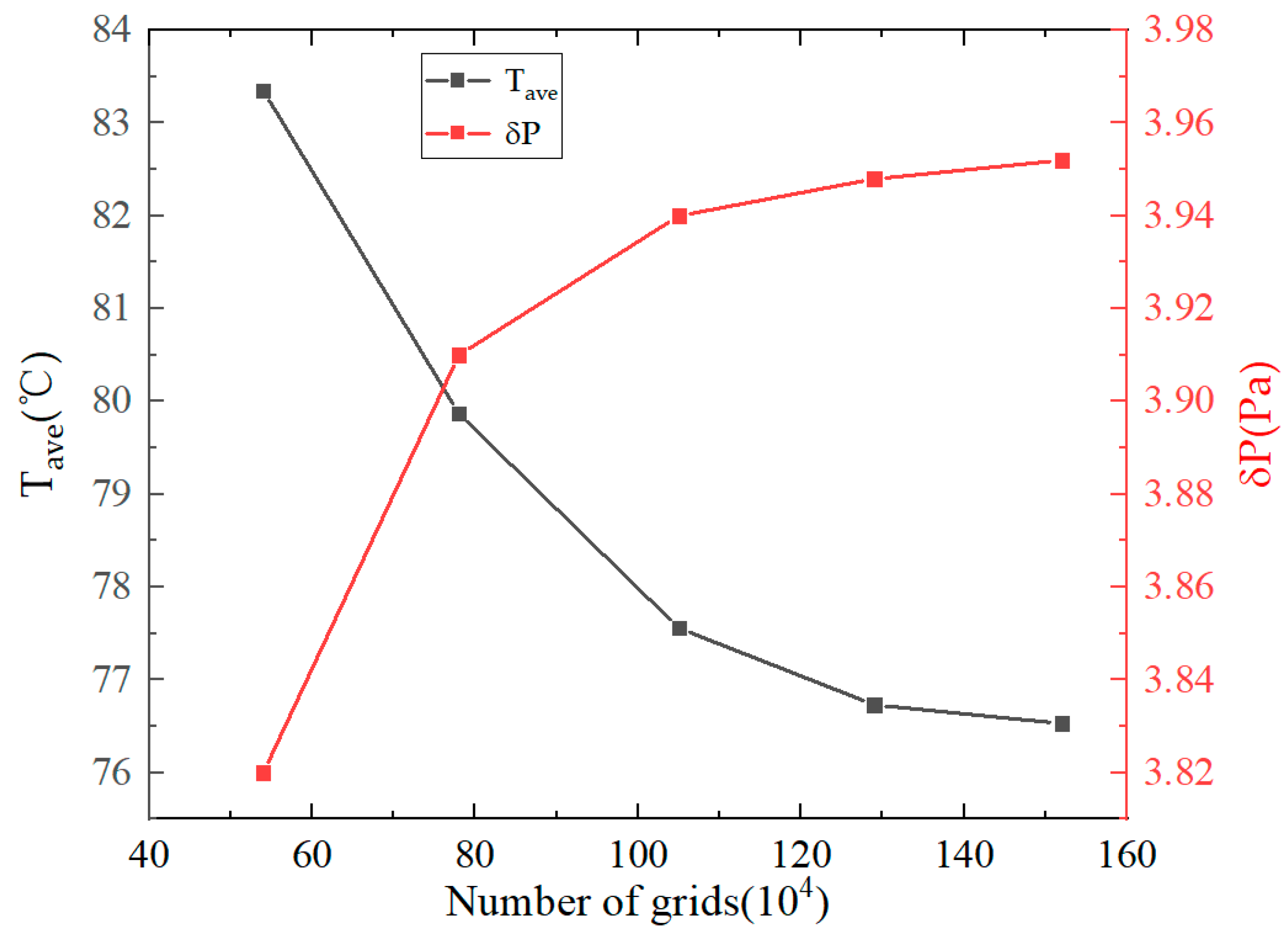
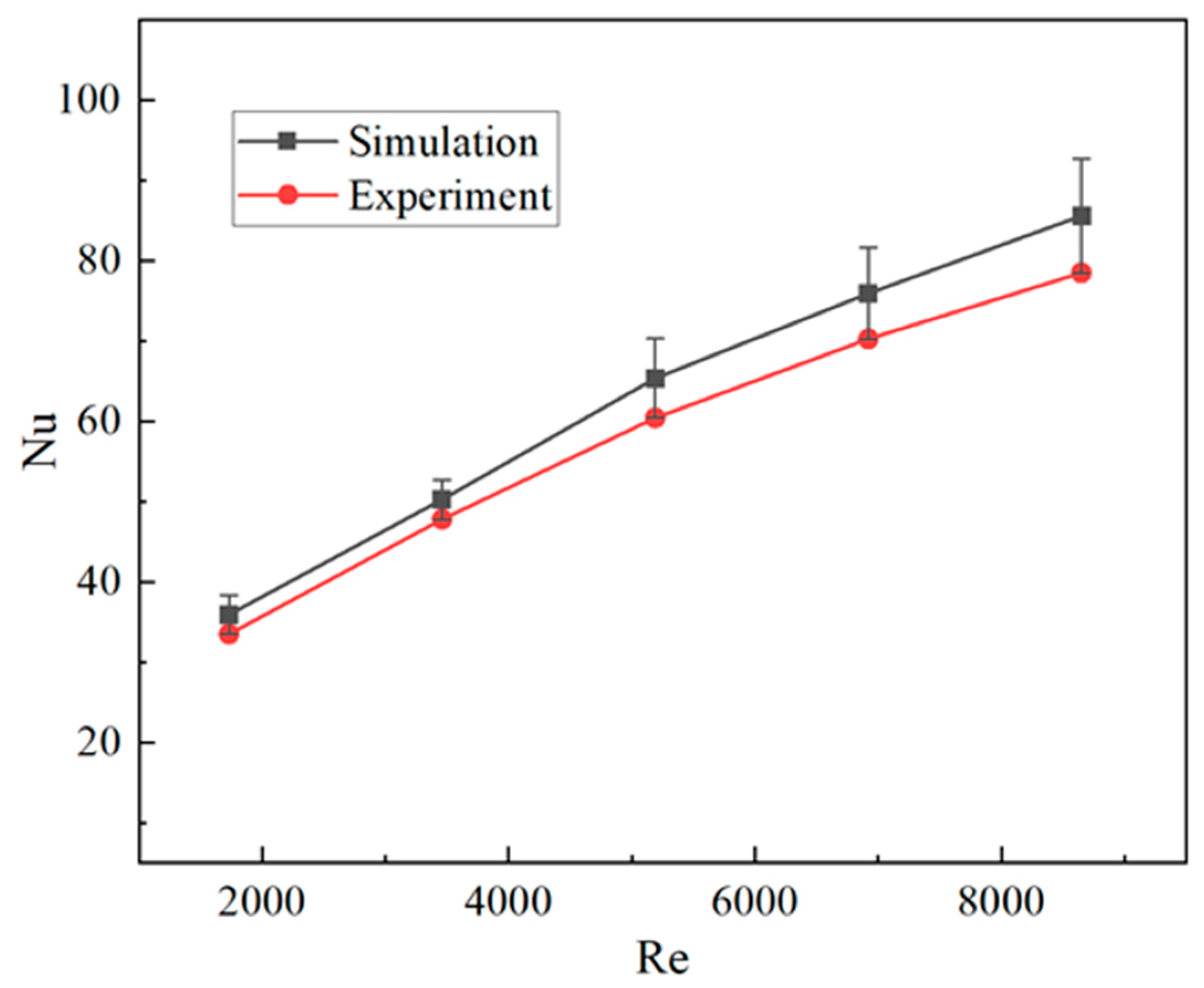
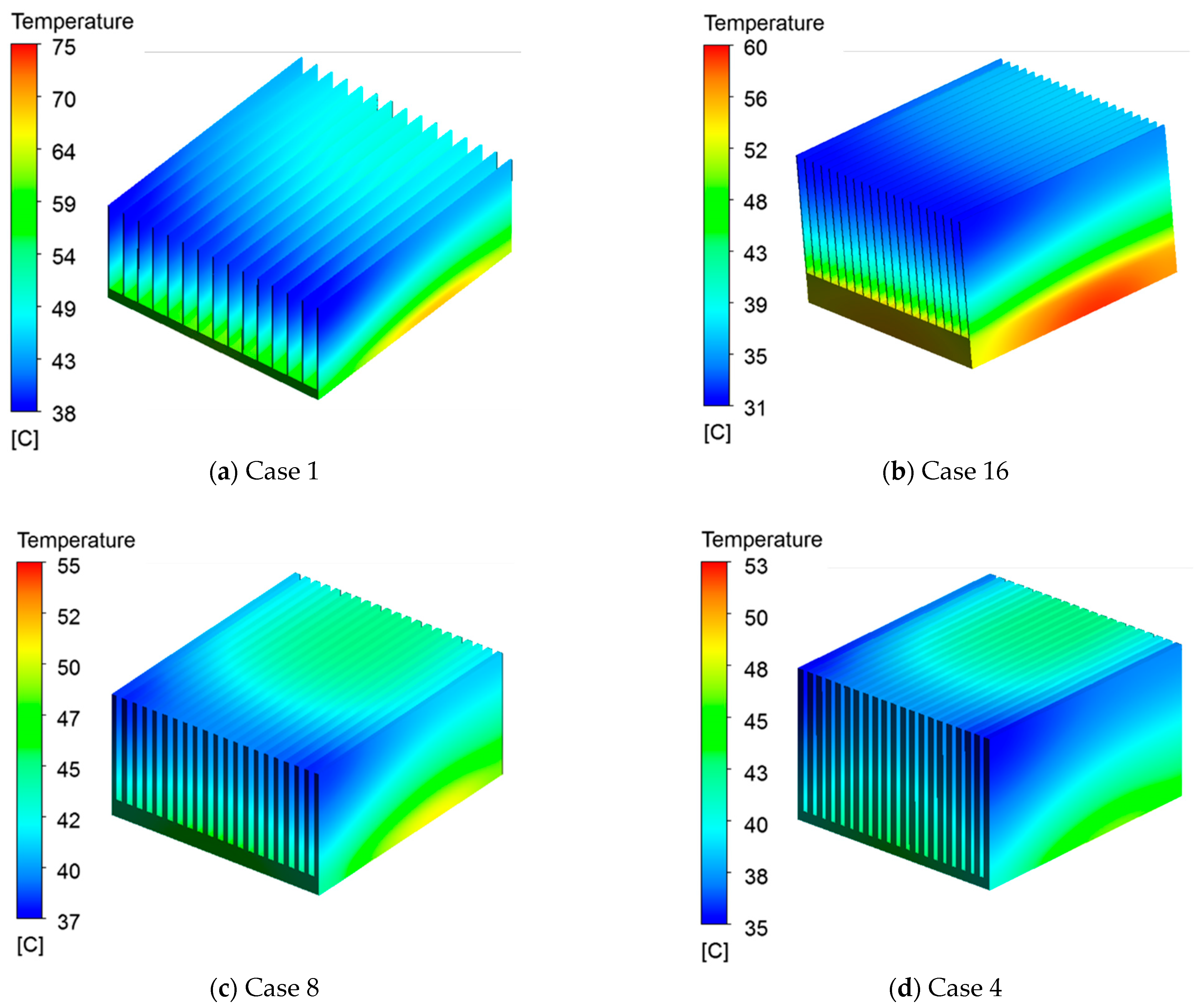
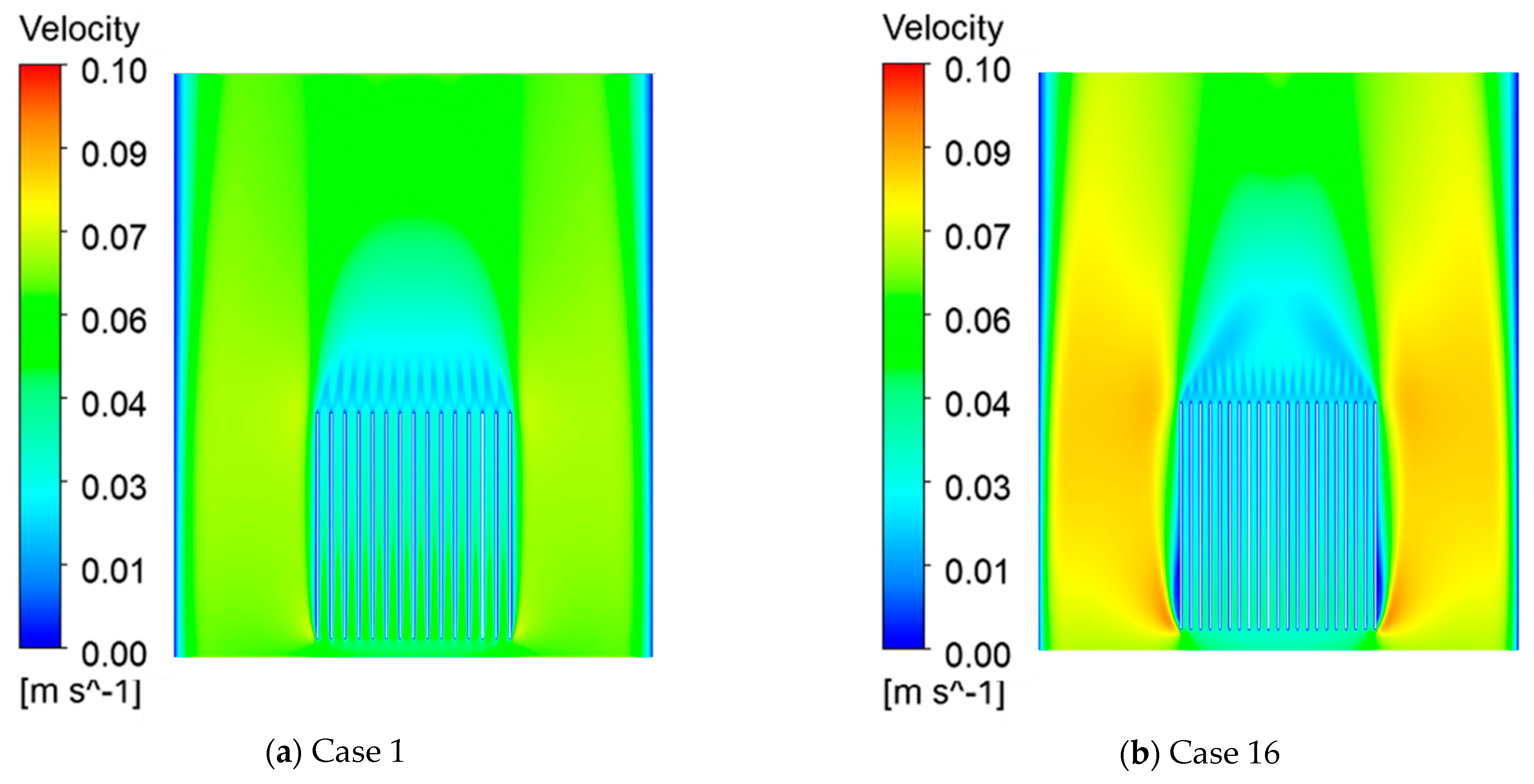
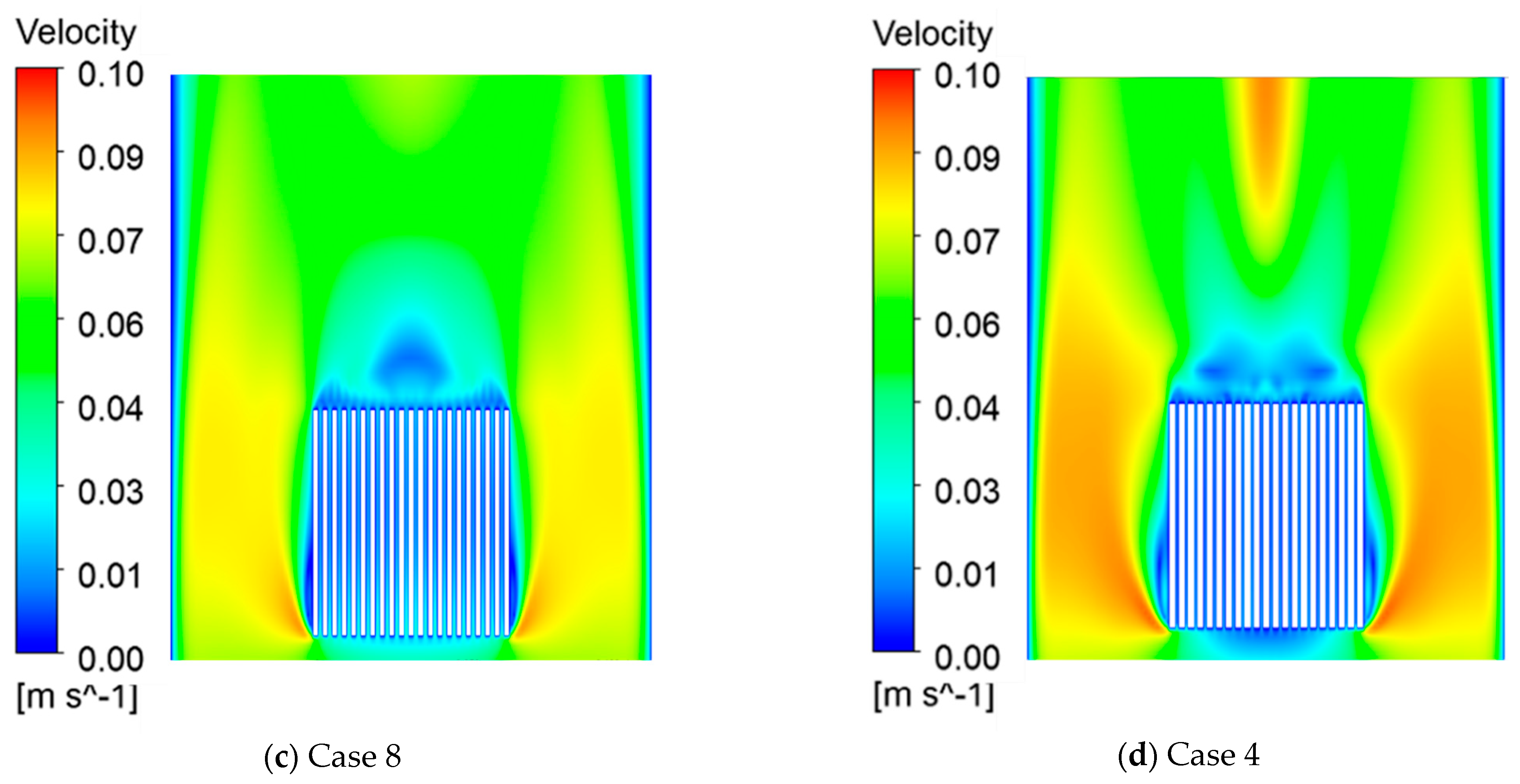

| Property | Value |
|---|---|
| Density (kg/m3) | 1903 − 2.15 × T (°C) |
| Specific heat (J/(kg·K)) | 1100 |
| Thermal conductivity(W/(m·K)) | 0.065 |
| Dynamic viscosity (mPa·s) | 3.4 |
| Boiling point (°C) | 155 |
| Level | Factor | |||
|---|---|---|---|---|
| B (mm) | N | W (mm) | H (mm) | |
| 1 | 3 | 15 | 0.5 | 25 |
| 2 | 5 | 17 | 1.0 | 30 |
| 3 | 7 | 19 | 1.5 | 35 |
| 4 | 9 | 21 | 2.0 | 40 |
| Case | B | N | W | H | Blank |
|---|---|---|---|---|---|
| 1 | 1 | 1 | 1 | 1 | 1 |
| 2 | 1 | 2 | 2 | 2 | 2 |
| 3 | 1 | 3 | 3 | 3 | 3 |
| 4 | 1 | 4 | 4 | 4 | 4 |
| 5 | 2 | 1 | 2 | 3 | 4 |
| 6 | 2 | 2 | 1 | 4 | 3 |
| 7 | 2 | 3 | 4 | 1 | 2 |
| 8 | 2 | 4 | 3 | 2 | 1 |
| 9 | 3 | 1 | 3 | 4 | 2 |
| 10 | 3 | 2 | 4 | 3 | 1 |
| 11 | 3 | 3 | 1 | 2 | 4 |
| 12 | 3 | 4 | 2 | 1 | 3 |
| 13 | 4 | 1 | 4 | 2 | 3 |
| 14 | 4 | 2 | 3 | 1 | 4 |
| 15 | 4 | 3 | 2 | 4 | 1 |
| 16 | 4 | 4 | 1 | 3 | 2 |
| Case | B (mm) | N | W (mm) | H (mm) | Wc (mm) | Tmax (°C) | Rank |
|---|---|---|---|---|---|---|---|
| 1 | 3 | 15 | 0.5 | 25 | 4.10 | 83.81 | 1 |
| 2 | 3 | 17 | 1.0 | 30 | 3.00 | 66.92 | 5 |
| 3 | 3 | 19 | 1.5 | 35 | 2.03 | 58.98 | 13 |
| 4 | 3 | 21 | 2.0 | 40 | 1.15 | 55.47 | 16 |
| 5 | 5 | 15 | 1.0 | 35 | 3.57 | 67.85 | 4 |
| 6 | 5 | 17 | 0.5 | 40 | 3.53 | 73.34 | 2 |
| 7 | 5 | 19 | 2.0 | 25 | 1.50 | 60.68 | 11 |
| 8 | 5 | 21 | 1.5 | 30 | 1.68 | 57.98 | 14 |
| 9 | 7 | 15 | 1.5 | 40 | 3.04 | 62.07 | 9 |
| 10 | 7 | 17 | 2.0 | 35 | 1.94 | 57.88 | 15 |
| 11 | 7 | 19 | 0.5 | 30 | 3.08 | 69.84 | 3 |
| 12 | 7 | 21 | 1.0 | 25 | 2.20 | 61.70 | 10 |
| 13 | 9 | 15 | 2.0 | 30 | 2.50 | 62.41 | 8 |
| 14 | 9 | 17 | 1.5 | 25 | 2.47 | 63.77 | 7 |
| 15 | 9 | 19 | 1.0 | 40 | 2.56 | 60.01 | 12 |
| 16 | 9 | 21 | 0.5 | 35 | 2.73 | 65.41 | 6 |
| Parameter | Factor | |||
|---|---|---|---|---|
| B | N | W | H | |
| K1j | 265.18 | 276.14 | 292.40 | 269.96 |
| K2j | 259.85 | 261.91 | 256.48 | 257.15 |
| K3j | 251.49 | 249.51 | 242.80 | 250.12 |
| K4j | 251.60 | 240.56 | 236.44 | 250.89 |
| k1j | 66.29 | 69.03 | 73.10 | 67.49 |
| k2j | 64.96 | 65.47 | 64.12 | 64.28 |
| k3j | 62.87 | 62.38 | 60.70 | 62.53 |
| k4j | 62.90 | 60.14 | 59.11 | 62.72 |
| Rj | 3.42 | 8.89 | 13.99 | 4.96 |
| Case | Tmax (°C) | Mass (kg) | fT | fM | F |
|---|---|---|---|---|---|
| 1 | 83.81 | 0.37 | 0.00 | 1.00 | 0.25 |
| 2 | 66.92 | 0.43 | 0.60 | 0.76 | 0.64 |
| 3 | 58.98 | 0.50 | 0.88 | 0.52 | 0.79 |
| 4 | 55.47 | 0.57 | 1.00 | 0.28 | 0.82 |
| 5 | 67.85 | 0.53 | 0.56 | 0.43 | 0.53 |
| 6 | 73.34 | 0.59 | 0.37 | 0.20 | 0.33 |
| 7 | 60.68 | 0.40 | 0.82 | 0.90 | 0.84 |
| 8 | 57.98 | 0.46 | 0.91 | 0.66 | 0.85 |
| 9 | 62.07 | 0.62 | 0.77 | 0.09 | 0.60 |
| 10 | 57.88 | 0.55 | 0.91 | 0.33 | 0.77 |
| 11 | 69.84 | 0.49 | 0.49 | 0.57 | 0.51 |
| 12 | 61.70 | 0.42 | 0.78 | 0.81 | 0.79 |
| 13 | 62.41 | 0.51 | 0.76 | 0.47 | 0.68 |
| 14 | 63.77 | 0.45 | 0.71 | 0.71 | 0.71 |
| 15 | 60.01 | 0.64 | 0.84 | 0.00 | 0.63 |
| 16 | 65.41 | 0.58 | 0.65 | 0.24 | 0.55 |
| Case | B (mm) | N | W (mm) | H (mm) |
|---|---|---|---|---|
| 8 | 5 | 21 | 1.5 | 30 |
Publisher’s Note: MDPI stays neutral with regard to jurisdictional claims in published maps and institutional affiliations. |
© 2021 by the authors. Licensee MDPI, Basel, Switzerland. This article is an open access article distributed under the terms and conditions of the Creative Commons Attribution (CC BY) license (http://creativecommons.org/licenses/by/4.0/).
Share and Cite
Li, B.; Cui, Z.; Cao, Q.; Shao, W. Increasing Efficiency of a Finned Heat Sink Using Orthogonal Analysis. Energies 2021, 14, 782. https://doi.org/10.3390/en14030782
Li B, Cui Z, Cao Q, Shao W. Increasing Efficiency of a Finned Heat Sink Using Orthogonal Analysis. Energies. 2021; 14(3):782. https://doi.org/10.3390/en14030782
Chicago/Turabian StyleLi, Bin, Zheng Cui, Qun Cao, and Wei Shao. 2021. "Increasing Efficiency of a Finned Heat Sink Using Orthogonal Analysis" Energies 14, no. 3: 782. https://doi.org/10.3390/en14030782
APA StyleLi, B., Cui, Z., Cao, Q., & Shao, W. (2021). Increasing Efficiency of a Finned Heat Sink Using Orthogonal Analysis. Energies, 14(3), 782. https://doi.org/10.3390/en14030782






